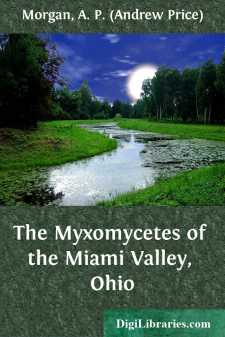Categories
- Antiques & Collectibles 13
- Architecture 36
- Art 48
- Bibles 22
- Biography & Autobiography 813
- Body, Mind & Spirit 142
- Business & Economics 28
- Children's Books 15
- Children's Fiction 12
- Computers 4
- Cooking 94
- Crafts & Hobbies 4
- Drama 346
- Education 46
- Family & Relationships 57
- Fiction 11829
- Games 19
- Gardening 17
- Health & Fitness 34
- History 1377
- House & Home 1
- Humor 147
- Juvenile Fiction 1873
- Juvenile Nonfiction 202
- Language Arts & Disciplines 88
- Law 16
- Literary Collections 686
- Literary Criticism 179
- Mathematics 13
- Medical 41
- Music 40
- Nature 179
- Non-Classifiable 1768
- Performing Arts 7
- Periodicals 1453
- Philosophy 64
- Photography 2
- Poetry 896
- Political Science 203
- Psychology 42
- Reference 154
- Religion 513
- Science 126
- Self-Help 84
- Social Science 81
- Sports & Recreation 34
- Study Aids 3
- Technology & Engineering 59
- Transportation 23
- Travel 463
- True Crime 29
The Myxomycetes of the Miami Valley, Ohio
Categories:
Description:
Excerpt
MYXOMYCETES, Wallr.
Fructification essentially a minute membranaceous vesicle, the SPORANGIUM inclosing the SPORES, the product of a motile protoplasmic body called the PLASMODIUM.
Microscopic organisms with the habit of the Fungi. The ripe spore of the Myxomycetes is globose or ellipsoidal in shape, with the epispore colorless or colored, and smooth or marked by characteristic surface—sculpture according to the species; the spore in germination gives rise to an elongated protoplasmic body, which exhibits amoeboid movements, and is known by the name of swarm-cell. The swarm-cells multiply by bipartition, which may be repeated through several generations; they then unite together to form the large motile protoplasmic bodies named plasmodia. The newly-formed plasmodium is distinguished by its greater size from the swarm-cells, while it exhibits essentially the same movements and changes of shape. The plasmodia gradually increase in size, and as they grow assume commonly the form of branched strands; these spread over the surface of the substratum, which is usually the decaying parts of plants, in the form of veins and net-works of veins, giving rise to a copiously-branched reticulated or frill-like expansion, which covers surfaces varying in extent from a few to several centimeters. They are chiefly composed of a soft protoplasm of the consistence of cream, which may be readily spread out into a shapeless smear, and is usually colorless, but sometimes exhibits brilliant colors of yellow, orange, rose, purple, etc. The development of the plasmodium ceases with the formation of the spores within their sporangia.
The formation of the sporangia out of the plasmodium appears under three general forms, which, however, pass into each other and are, therefore, not strictly limited.
First: An entire plasmodium spread out on its substratum becomes transformed into a sporangium, or it divides into a variable number of unequal and irregular pieces, each of which undergoes transformation. Such a sporangium lying flat on the substratum, more or less elongated and flexuous, often branched and reticulate, is termed a plasmodiocarp.
Second: Erect sporangia on a narrow or stalk-like base, begin as node-like swellings on the branches of the plasmodium, and gradually rise to their ultimate form as the surrounding protoplasm flows into them and assumes an upward direction. These sporangia are nearly always perfectly regular in shape; they may be globose, obovoid, somewhat depressed, or more or less elongated, and are either stipitate or sessile.
Third: A number of plasmodia collect together from every side and become fused into a single body, often of considerable dimensions; from these combinations originate the large spore-receptacles which are called æthalia. The component sporangia may be regular in shape, standing close together, in a single stratum, with entire connate walls; more often, being elongated and flexuous, they branch and anastomose freely, their walls becoming perforated and more or less defective; in other cases, the æthalium is a compound plasmodiocarp, the narrow sinuous sporangia branched and anastomosing in all directions, forming an intricate network, closely packed together and inseparable. The surface of the æthalium is often covered by a continuous layer of some excreted substance, which is called the common cortex.
The wall of the sporangium, typically, is a thin, firm membrane, colorless and pellucid, or colored in various shades of violet, brown, yellow, etc.; it is sometimes extremely delicate, as in Lamproderma, or is scarcely evident, as in Stemonitis; in other instances it is thickened by deposits on the inner surface, as in Tubulina, or by incrustations on the outer surface, as in Chondrioderma....


